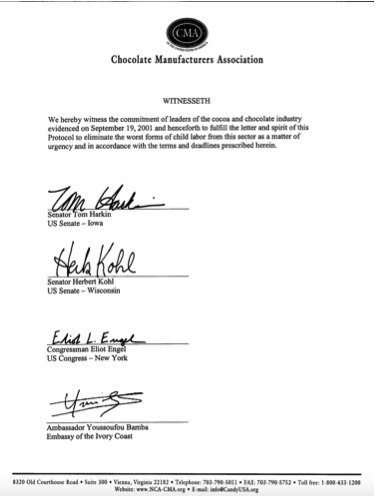Child Labor and Slavery
Africa's Child Labor Problem
Children in Africa have worked in farms and at home over a long history. This is not unique to Africa as large numbers of children have worked in agriculture and domestic situations in America, Europe and every other society, throughout history, prior to the 1950s. Scholars suggest that this work, especially in rural areas, was a form of schooling and vocational education, where children learned the arts and skills from their parents, and as adults continued to work in the same hereditary occupation. Ivory Coast, Ghana, and other West African cocoa producing nations have come under severe criticism in the west for pushing this idea too far and accused of using child slave labor to produce the cocoa purchased by Western chocolate companies. The bulk of the criticism has been directed towards practices in Ivory Coast. The report "A Taste of Slavery: How Your Chocolate May be Tainted"[4] claims that traffickers promise paid work, housing, and education to children who are then forced into labour and undergo severe abuse. Additionally it is reported that some children are held forcibly on farms and work up to 100 hours per week, and any attempted escapees are beaten. A BBC article claimed that 15,000 children from Mali, some under age 11, were working as slaves in cocoa production in Ivory Coast, and Mali's Save the Children Fund director described "young children carrying 6 kg of cocoa sacks so heavy that they have wounds all over their shoulders."[5]. A BBC video also showed a segment about child labor conditions in the Ivory Coast. The segment showed the living and working conditions of these children and interviewed a few of them. One child said he was over 200 miles away from home and hasn't seen his family in three years. The land owner did not even know one child's name[6].
Harkin Engel Protocol
In 2001 the Chocolate Manufacturers Association acknowledged that slaves harvested some cocoa. Signed on September 19, 2001, the Harkin Engel Protocol was created by many the major chocolate manufacturers such as Hershey and Mars in an attempt to stop child labor in cocoa harvestation. The document was originally signed in 2001 and checked back on in 2005, 2008 and 2010 where there were joint statements signed showing the company's commitment to ending the problem.
Although it has been close over 15 years since the initial signing, we have yet to see the effects of the protocol. Officials and researchers on the matter are taking notice. The ‘protocol’ was intended to assure consumers that chocolate companies were acting ethically and ending forced and trafficked child labor in their cocoa supply. The industry has failed to undertake meaningful supply chain reforms. None of the activities undertaken under the auspices of the ‘protocol’ have attempted to monitor or improve labor conditions within the cocoa supply of any chocolate company. Indeed for seven years, all the major chocolate companies, as well as industry associations and cocoa traders, have maintained that tracking or monitoring conditions within their own supply chains is impossible[7].
3. Loretta Bass (2004). Child Labor in Sub-Saharan Africa. Lynne Rienner Publications. pp. 30–43
4. Raghavan, Sudarsan; Sumana Chatterjee (June 24, 2001). "Slaves feed world's taste for chocolate: Captives common in cocoa farms of Africa". Milwaukee Journal Sentinel.
5. Hawksley, Humphrey (April 12, 2001). "Mali's children in chocolate slavery". BBC.
6. “Cocoa Farms in Ivory Coast Still Using Child Labour.” BBC News, BBC, www.bbc.com/news/av/world-africa-15686731/cocoa-farms-in-ivory-coast-still-using-child-labour.
7.Findings from 2013/14 Survey of Child Labor in the Cocoa Growing Areas, www.childlaborcocoa.org/index.php/2013-14-final-report

